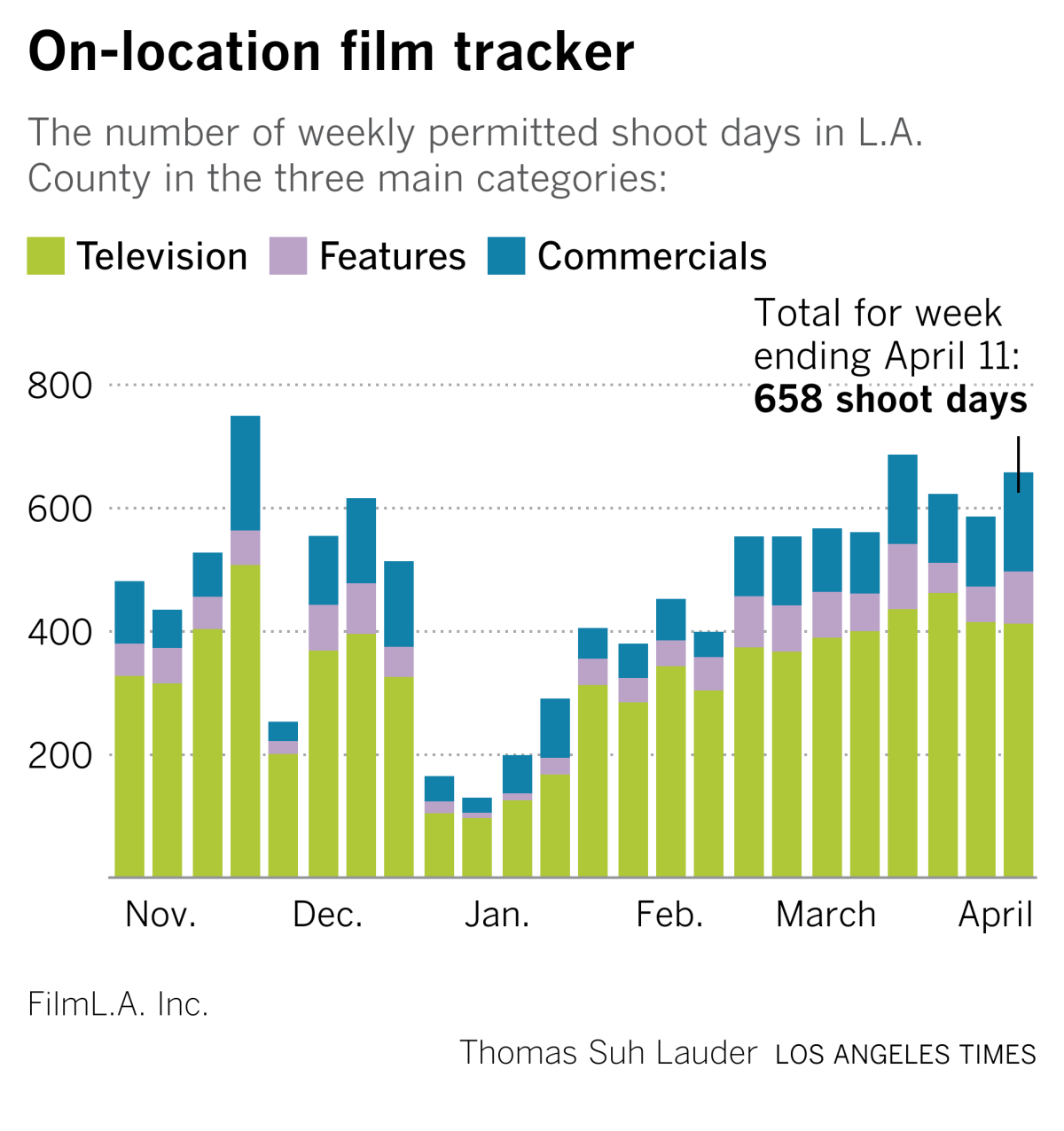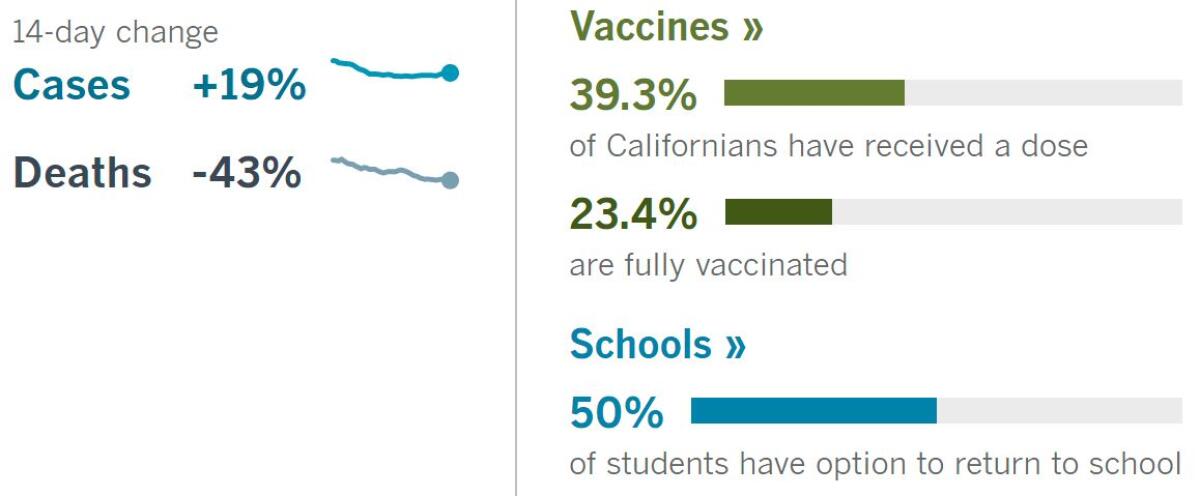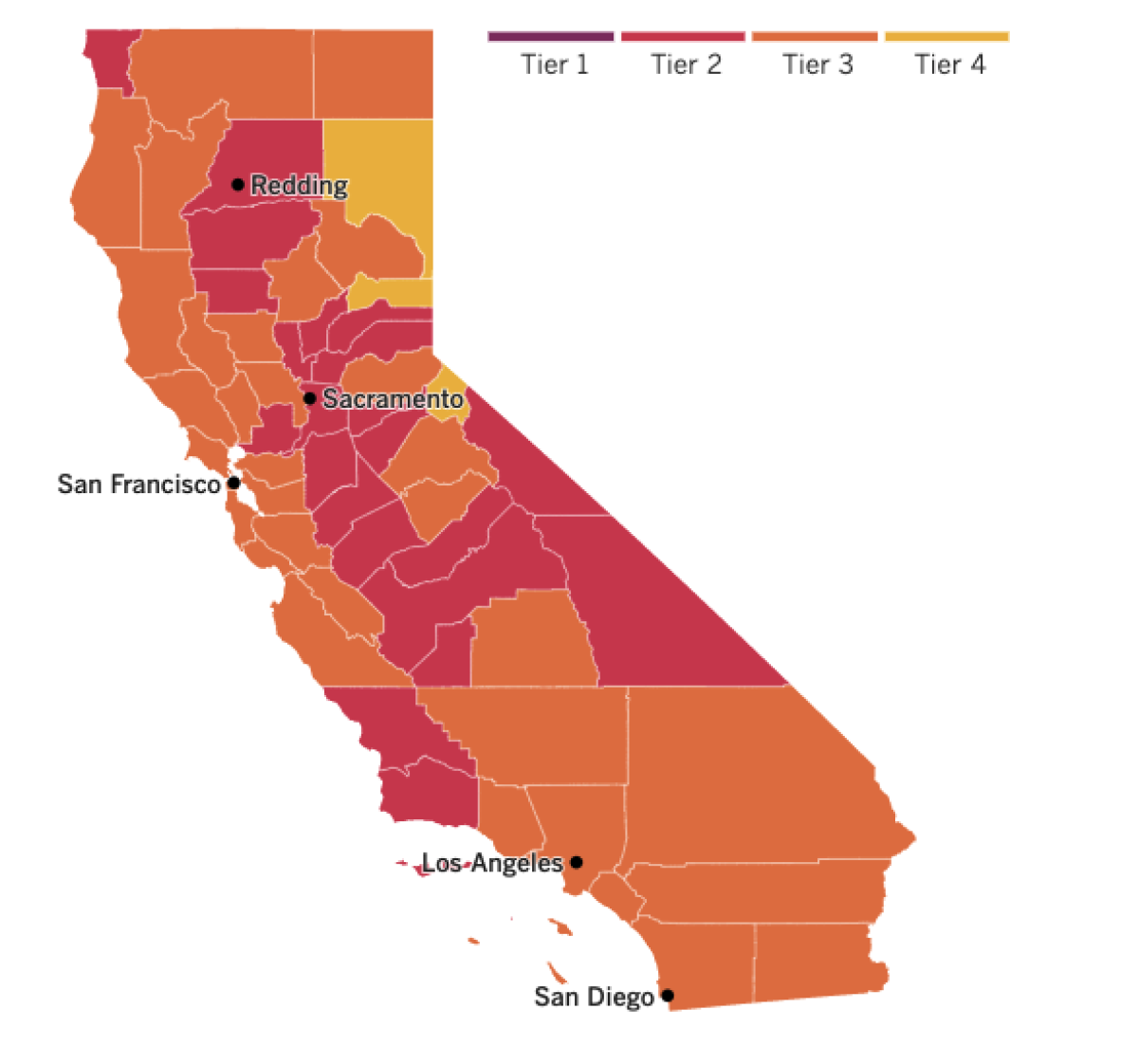Coronavirus Today: A Hollywood reopening
- Share via
Good evening. I’m Melody Petersen, and it’s Wednesday, April 14. Here’s what’s happening with the coronavirus in California and beyond.
Hollywood is awakening from the pandemic.
TV and film production crews are again taking over parking lots, yellow signs telling workers where to go. Movie theaters are open and actually starting to show big films. Prop houses and other local businesses dependent on the film and television industry are returning to life.
With vaccinations rolling out across the country and Gov. Gavin Newsom setting a target to reopen the state’s economy by June 15, there’s a growing sense in the entertainment industry that things are finally on the mend, write my colleagues Ryan Faughnder and Anousha Sakoui.
That should come as a relief for the state’s economy, of which entertainment jobs are a key driver.
Armando Santana, 56, a Teamsters Local 399 driver shuttling film trailers and actors, spent several months out of work last year after government restrictions shut down production. The 20-year veteran Teamster has had to navigate the industry’s various starts and stops since getting back to work in July. Recently, however, jobs have been steady.
“It seems like the business has been very, very busy,” Santana said. “I’m grateful for that. I probably would find it hard to go through a couple more shutdowns.”
Production stoppages and other pandemic impacts walloped employment in the motion picture and sound recording industry. The number of people employed in L.A. County fell from 152,500 to 92,000 from Feb. 1, 2020, to Jan. 1, 2021.
But in a business that spent the bulk of 2020 either in partial closure or inching toward recovery, there’s now a palpable, if cautious, sense of optimism.
Production in greater L.A. has rebounded to reach about 60% of the normal activity levels the industry would expect this time of year, according to movie-permitting group FilmLA. That’s way up from January, when the number of permits issued collapsed to about 20% of normal after health officials and unions pressured productions to stop filming.

Certain film and TV business dealings can be done remotely, including scriptwriting, dealmaking, pitching, animation, visual effects and casting, and in some ways, how people work together using technology may never go completely back to the way it was.
But Hollywood is still a business that depends on spontaneous, in-person interaction, said multiple filmmakers, executives and other insiders who spoke with Ryan and Anousha.
For director Jon M. Chu, the promise of a return to normalcy being on the horizon could hardly have come at a better time. The “Crazy Rich Asians” filmmaker’s latest movie, a screen adaptation of Lin-Manuel Miranda’s Broadway musical “In the Heights,” is set for release in June.
Like many filmmakers and crew members, Chu experienced the disruption of the pandemic firsthand. In March 2020, Chu was in New York just days into the sound mix for “In the Heights” when the fast-spreading coronavirus sent Americans fleeing offices. The team didn’t restart work on the film until August, after the studio relocated post-production to L.A.
“Just in the past few weeks, things are definitely starting to shift,” said Chu, who lives in West Hollywood. “I’m able to have a meeting with my creative executive in my backyard, and we’re socially distanced and masked, but I don’t feel as self-conscious or unsafe doing that. That edge is off a bit.”
For more industry news and analysis and our exclusive film production tracker, sign up for the Wide Shot, Ryan’s newsletter about the entertainment business.
By the numbers
California cases, deaths and vaccinations as of 6:47 p.m. Wednesday:

Track California’s coronavirus spread and vaccination efforts — including the latest numbers and how they break down — with our graphics.

Across California
In Los Angeles County, 289 out of every 100,000 men have died from COVID-19, along with 153 of every 100,000 women. Yet despite their greater risk of death, men in the county are less likely to get vaccinated — 30% of them have received at least one dose of a COVID-19 vaccine, compared with 44% of women, my colleague Soumya Karlamangla reports.
The county is hardly an outlier when it comes to this gender disparity. In the 38 states that have published a gender breakdown of vaccination rates, more women have been vaccinated than men in all of them, according to Kaiser Health News.
The gap exists in part because vaccinations were initially offered to healthcare workers and the elderly, groups that are disproportionately composed of women. But it also likely reflects longstanding patterns of men engaging in riskier behavior and paying less attention to their health than women, experts say.
Barbara Ferrer, L.A. County’s public health director, described a man she met at a vaccination site over the weekend. He had brought his adult children so they could be immunized against the disease, which he felt was important. But he wasn’t concerned about his own risk, even considering his older age.
“What’s staggering to realize is that the very group of folks who have the higher mortality rate are now also the group of folks that have the lower vaccination rates,” Ferrer said.
She said the health department would target vaccine messaging at men and improving access to the vaccine. Distribution is particularly low among Black and Latino men in L.A. County, with only 19% and 17%, respectively, having gotten one shot of the vaccine so far, according to county data.
“You obviously want people at highest risk to be getting vaccinated and to be getting vaccinated quickly,” Ferrer said.
State officials say they remain confident that the unexpected pause in the administration of Johnson & Johnson‘s COVID-19 vaccine won’t slow the race to vaccinate as many people as possible or change their plans to expand vaccine eligibility this week to all residents 16 and older. They also don’t expect it to throw off their timeline for fully reopening the economy in two months.
Less than 4% of California’s allocation of vaccine from the federal government this week — 67,600 out of roughly 2 million doses expected — had been expected to be from Johnson & Johnson.
“As the federal government has said, we do not expect a significant impact to our vaccination allocations,” said state epidemiologist Dr. Erica Pan.
The reassurances come after federal health officials recommended on Tuesday that states temporarily stop giving out the Johnson & Johnson vaccine because of six reports of a rare blood clot condition. So far 7.2 million doses of that vaccine have been administered nationwide, making the condition extremely rare.
That vaccine will remain in limbo a while longer after U.S. health advisors told the government at an emergency meeting Wednesday that they need more time to gather evidence about whether the clots were linked to the shot — and if so, how big the potential risk is.
The cases that prompted the warning involve six women ages 18 to 48 who developed a blood clot syndrome called cerebral venous sinus thrombosis six to 13 days after receiving the vaccine. Federal officials recommended the J&J timeout in part to make sure doctors know how to recognize and treat the unusual condition.
People who have received a dose of the J&J vaccine in recent weeks should contact their healthcare provider if they experience severe headaches, abdominal pain, leg pain or shortness of breath — all symptoms of the rare condition. Health officials caution against confusing the normal flu-like symptoms that occur a day or two after many COVID-19 vaccinations with the clot syndrome.
Meanwhile in Orange County, officials say they don’t plan to require vaccine “passports,” after plans for a pilot program faced a public backlash.
On Tuesday, about 200 residents showed up at a Board of Supervisors meeting to oppose those plans. Orange County Health Care Agency Director Clayton Chau told those in attendance that the county isn’t requiring a vaccine passport but instead plans to offer a digital vaccination record to residents who request it. The record will likely be in the form of a scannable barcode in the Othena app, which the county has used for scheduling coronavirus testing and vaccinations.
Chau said the digital record may be useful as more people get shots and the economy reopens. Some businesses may decide to only admit those who have been vaccinated, he said, but the county is not requiring anyone to get the vaccines.
Supervisor Don Wagner pressed Chau on whether the digital records would perch the county atop a slippery slope.
“We’ve got 200 people who want to speak about this, and they are concerned that at some point we are going to say, ‘Without the digital equivalent of this card or something else, you’re not going to be able to travel in Orange County, you’re not going be able to come in to Orange County and leave Orange County, you’re not going to be able to go to a grocery store,’” Wagner said. “That is not what we’re doing, that is not what you’re intending, and you will resist that if ever somebody proposes it to you, right?”
“That’s correct,” Chau said.


See the latest on California’s coronavirus closures and reopenings, and the metrics that inform them, with our tracker.
Consider subscribing to the Los Angeles Times
Your support helps us deliver the news that matters most. Become a subscriber.
Around the nation and the world
Expect the pandemic’s effects to contribute over the next year to “humanitarian and economic crises, political unrest and geopolitical competition,” U.S. intelligence officials warned in their annual worldwide threat assessment.
The new report raises concerns about the lingering impact of the pandemic, which has killed nearly 3 million people worldwide. And it warns about the ways in which the recovery will “strain governments and societies.”
The pandemic has already disrupted crucial health services in parts of the world and will lead to continued health emergencies, and the ongoing health crisis has raised tensions as countries compete for advantage, the report says. In developing countries, the economic fallout has been especially severe, with food insecurity worldwide at its highest point in more than a decade.
“No country has been completely spared,” the report says, “and even when a vaccine is widely distributed globally, the economic and political aftershocks will be felt for years.”
For Americans who have lost their jobs during the pandemic, a new federal law may offer free COBRA healthcare.
Under the federal $1.9-trillion COVID-19 relief package, those who lost a job in the last 18 months are able to stay on or join their former employer’s healthcare plan for free through Sept. 30.
Under the provision, which took effect April 1, those eligible include anyone who involuntarily lost their job or health insurance or had their hours reduced within the last 18 months. A government subsidy covers the health plan’s premium, but participants are still responsible for copays and deductibles.
More than 2 million people could benefit, according to the Congressional Budget Office.
In other news, dozens of Americans are rolling up their sleeves for a third dose of COVID-19 vaccine — this time for shots tweaked to guard against a worrisome coronavirus variant.
The vaccines currently being administered across the U.S. offer strong protection against COVID-19. But new studies of experimental updates to the Moderna and Pfizer-BioNTech vaccines mark a critical first step toward a backup plan if the virus should eventually outsmart today’s shots.
“We need to be ahead of the virus,” said Dr. Nadine Rouphael of Emory University, who is helping to lead a study of Moderna’s tweaked candidate. “We know what it’s like when we’re behind.”
It’s not clear if or when protection would wane enough to require an update but, “realistically we want to turn COVID into a sniffle,” she said.
Viruses constantly evolve, and the world is in a race to vaccinate millions and tamp down the coronavirus before even more variants emerge.
In suburban Atlanta, Emory asked people who received Moderna’s original vaccine a year ago in a first-stage study to also help test the updated shot. Volunteer Cole Smith said returning wasn’t a tough decision.
“The earlier one, it was a great success and, you know, millions of people are getting vaccinated now,” Smith said. “If we’re helping people with the old one, why not volunteer and help people with the new one?”
Your questions answered
Today’s question comes from readers who want to know: Can the government require proof of vaccination?
Public debate has become heated recently about whether governments can require what are known as vaccine passports — official records of whether people have received the shots.
Could such passports dictate where we work and play, whether we can go to school, or how we travel?
In short, they could at the state level, but for the most part not at the federal level, writes Times staff writer Melissa Healy.
The Biden administration has said it will not issue vaccine passports. A federal mandate requiring the passports would be “questionable legally, and there’s not much precedent,” said Lawrence Gostin, a Georgetown University expert on public health law. But people coming to the U.S. from other countries, including Americans, might reasonably be required to show they’ve been vaccinated, said Dr. Marcus Plescia, medical director of the Assn. of State and Territorial Health Officials.
Yet states have the authority to mandate vaccinations against infectious diseases and require proof — and they’ve done so for more than a century. The Supreme Court has repeatedly upheld their authority to require vaccinations against childhood diseases for attendance at schools and employment in sectors where the risk of infection are high, Gostin said.
In the near term, however, there’s another complication that could make it nearly impossible for governments to require the passports.
The current vaccines are dispensed under an emergency use authorization from the U.S. Food and Drug Administration. Until the shots gain the agency’s formal approval, they are still considered “investigational.” So a person’s reluctance to take it on safety grounds probably would not be grounds for denying her anything.
We want to hear from you. Email us your coronavirus questions, and we’ll do our best to answer them. Wondering if your question’s already been answered? Check out our archive here.
Resources
Need a vaccine? Keep in mind that supplies are limited, and getting one can be a challenge. Sign up for email updates, check your eligibility and, if you’re eligible, make an appointment where you live: City of Los Angeles | Los Angeles County | Kern County | Orange County | Riverside County | San Bernardino County | San Diego County | San Luis Obispo County | Santa Barbara County | Ventura County
Need more vaccine help? Talk to your healthcare provider. Call the state’s COVID-19 hotline at (833) 422-4255. And consult our county-by-county guides to getting vaccinated.
Practice social distancing using these tips, and wear a mask or two.
Watch for symptoms such as fever, cough, shortness of breath, chills, shaking with chills, muscle pain, headache, sore throat and loss of taste or smell. Here’s what to look for and when.
Need to get tested? Here’s where you can in L.A. County and around California.
Americans are hurting in many ways. We have advice for helping kids cope, resources for people experiencing domestic abuse and a newsletter to help you make ends meet.
We’ve answered hundreds of readers’ questions. Explore them in our archive here.
For our most up-to-date coverage, visit our homepage and our Health section, get our breaking news alerts, and follow us on Twitter and Instagram.




